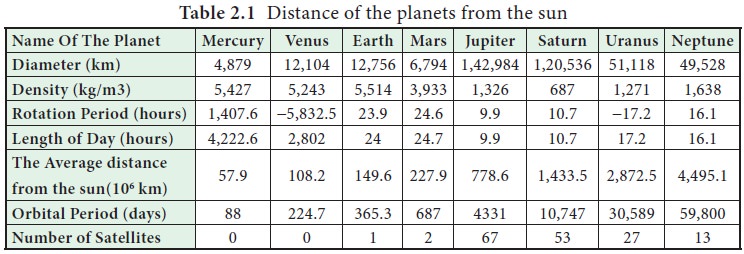Chapter: 11th Geography : Chapter 2 : The Solar system and the Earth
Planets in the Solar System
Planets
in the Solar System
The Mercury
Mercury is the nearest planet to the sun and it is
the smallest planet in the solar system. It does not have any satellite. It
rotates on its own axis in 58.65 earth days while it takes 88 Earth days to
complete one revolution around the sun. Mercury is 0.4 astronomical units away
from the Sun. The sunlight takes 3.2 minutes to travel from the Sun to Mercury.
Mercury is the second hottest planet though it is nearest to the sun.
The Venus
‘Venus’ is the second nearest planet to the sun. It is also called as ‘Earth’s Sister’ planet due to its similar size and mass as that of our Earth. It is the hottest planet in the solar system and experiences a mean surface temperature of 462° C. It is popularly known as “Morning star and Evening star” It is seen in the east sky before sunrise (dawn) in the morning and in the west sky after the sunset (twilight). It rotates clockwise i.e. east to west direction on its own axis. The rotation and orbit of the Venus are unusual in several ways. Venus is one of just two planets that rotate from east to west. Only Venus and Uranus have this ‘backwards’ rotation. It completes one rotation in 243 Earth days which is the longest day of any planet in our solar system. The Venus takes 224.7 Earth days to complete one revolution around the sun, and it has no natural satellites. Venus is 0.7 astronomical units away from the sun. The sunlight takes 6 minutes to travel from the sun to Venus.
The Earth
Earth is the third nearest planet to the sun. It is
the fifth largest planet in the solar system. The Earth’s orbit lies between
the orbits of Venus and Mars. It takes 23 hours 56 minutes and 4 seconds for
the earth to complete one rotation on its own axis. The Earth takes 365.25 days
(Table 2.1) to complete one revolution around the Sun. Earth’s surface
temperature varies from – 88q to 58° C and it is the densest planet in the
solar system.

The Earth is a unique planet because of its distance
from the sun, its motions, atmosphere with oxygen, presence of water and
moderate temperature. The earth is neither too close nor too far from the sun.
It is the only known planet to support life. It is also known as the ‘Blue Planet’ because of the presence of water. Earth has only one natural satellite called the Moon. The sun
light takes about 8.3 minutes to reach the earth.
The Mars
Mars is the fourth nearest planet to the sun and it
is the second smallest planet in the Solar system. It is also described as the “Red planet”. It is reddish in colour
due to the presence of iron oxide on
its surface. The landmass of Mars and Earth are very similar. It takes 24 hours
and 37 minutes to complete one rotation on its axis and its takes 687 days to
complete one revolution around the Sun. The surface temperature of the Mars is
ranging from -153q to 20° C. With the exception of the Earth, Mars probably is
the most hospitable to life. This planet has seasons, polar ice caps,
volcanoes, canyons and weather. Mars has two satellites namely Phobos and
Deimos.
The Jupiter
Jupiter is the largest planet in the solar system.
It is made primarily of gases and is therefore known as ‘Giant Gas planet’. It takes 9 hours 55 minutes to complete one
rotation on its axis and it takes 11.86 years to complete one revolution.
Jupiter has the shortest day in the solar system. Jupiter has a faint ring
system around it. They are mostly comprised of dust particles. Jupiter has 67
confirmed satellites orbiting the planet. Ganymede, the satellite of Jupiter,
is the largest natural satellite in the solar system (even bigger than the
planet Mercury).
The Saturn
Saturn is the sixth planet from the sun and the
second largest planet in the solar system. Saturn is called as the Ringed Planet. It is because of large,
beautiful and extensive ring systems that encircles the planet. These rings are
mostly made from the chunks of ice and carbonaceous dust. Saturn is the only planet in our solar system whose average density
is less than water.
The Saturn has 30 rings and 53confirmed natural
satellites. The Saturn takes 10 hours 34 minutes to complete one rotation on
its axis and it takes 29.4 years to complete one revolution around the sun.
The Uranus
Uranus is the seventh planet from the sun and it is
not visible to the naked eye. Like Venus, Uranus also rotates on its axis from
east to west. Uranus is inclined on its axis at an angle of 98 degrees. The
planet is almost lying on its side as it goes around the sun. The sunlight,
thus, is received mostly in the polar areas. Hydrogen, helium and methane are
the major gases of its atmosphere. It is very cold due to its great distance
from the sun. Uranus is named after the ancient Greek god of the sky. It has a
dense atmosphere primarily consisting of methane, which lends it a bluish-green
appearance. Uranus also has rings and twenty-seven satellites.
The Neptune
Neptune is the eighth planet from the sun. It takes
16 hours to complete one rotation on its own axis and it takes nearly 165 years
to revolve around the sun. It has 13 natural satellites and 5 rings. It is the coldest planet in the Solar System
because it is the farthest planet from the Sun. Neptune was the first planet
located through mathematical calculations. Neptune is our solar system’s
windiest planet.
Related Topics